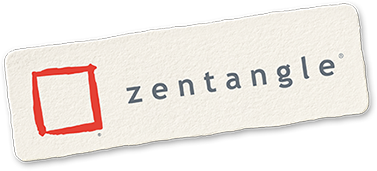Rick Roberts
This post is about the tangle paradox. For the tile below, I first drew a flower of life pencil string with a compass on a white Zentangle Opus Tile. Then I used a straight edge and pencil to connect certain points of the pattern. With a Sakura Pigma® Micron 01, I traced certain lines to define the triangles and trapezoids, some of which I left empty in the lower right.
In that almost empty lower-right hexagonal grid, I tangled a single triangle and a single trapezoid. I wanted you to see them standing alone because it is difficult to discern their individual forms when all the spaces are filled. This is because your eye is attracted, not to the underlying grid, not to the individual tangled triangles and trapezoids, but rather to the different meta-shapes that come into being across the borders of the grid.

If you look closely, you will notice that every stroke of this tangle is a straight line, at least to the extent that my hand-drawn lines are straight. Below is the "step-out" for the tangle paradox. A step-out is how, in the Zentangle Method, we graphically represent the individual sequence of elemental strokes that create tangles. This step-out is from the subscriber section of our Zentangle Mosaic app. The paradox of the paradox tangle is that by drawing only straight lines, you derive a gently curving spiral of logarithmic feel.

To emphasize how the original straight edge grid is integrated into spiraling meta-shapes, here is the original grid in red. Note that every line that the red overlay emphasizes remains, but without this overlay, it is nearly impossible to perceive those original lines as separate from the meta-shapes into which they are included and integrated.
Note also that only those two shapes are used throughout, sometimes rotating in one direction, sometimes in the other.

In this next image, notice how the gold and teal triangles in the upper right both rotate in a counter-clockwise manner, while the gold triangle in the lower left rotates in a clockwise manner.

In this next image you can see that, even though the gold and teal triangles in the upper right each rotate in the same direction, the meta-shapes that evolve are different. The teal displays fan shapes. The gold exhibits a twist shape. The meta-shape that evolves between to sections depends on their relative rotations. When two side-by-side sections rotate, or spin, in the same direction, you get a twist meta-shape. When they spin in opposite directions, you get a fan-like shape.

You can see that effect more clearly in this close-up image. When I take a moment to ponder this image, it suggests multi-dimensional butterfly wings revealing themselves inside a tangled hyper-cube animation (see resources list at end).

We began this tile with defined straight borders of two "competing" shapes . . . the triangle and the trapezoid. These shapes have obvious boundaries and obvious differences; one has three sides, one has four. How can they agree? Which one is better?
Individually, as each shape explores its inner potential, it uses the only structural element it has, the straight line. Yet as it uses this straight line to draw gradually smaller triangles or trapezoids, each discovers a similar inner curve.
The new meta-forms include and integrate every previous stroke—the original border lines and the individual inner lines. Nothing is lost, but much is gained as new meta-patterns appear.
As the image below shows, individual meta-shapes in turn form larger similar tessellated meta-shapes even when they have different component.

Ever the romantic, I love how these beautiful butterfly wing shapes that evolved through the transformation and intimate association of triangle and trapezoid echo the underlying proportions of the original flower of life grid with its "golden" proportions.
I look forward to reading your comments.
Rick
__________
Resources:
Zentangle Mosaic App for iPhone and Android
Tesselation definition and examples - Wikipedia
Hypercube Animations:
- A good example of hypercube or tesseract animation.
- Bell Labs Animation - From the mid 1960s, one of the first stereoscopic digital computer animations. Way cool if you can watch it cross-eyed to get the depth perception effect.



https://www.pinterest.dk/pin/295900638030029705/
Hope you can help me.
Halil on
Dear Rick,
In your article, you mention the “golden” proportions. What measurements would you take to prove the golden ratio here?
Prerna Agarwal on
I have been exploring Zentangle for a couple of weeks now. I am totally hooked.
I’d like to ask about the use of compasses and straight edges. I can see from this blog post that you used both, so I guess that is allowed… I see so many tangles that are so perfect, it is a relief to read this blog. Part of the charm of the ones I have done so far is that they are so off kilter, but I would like to try something more symmetrical. Thanks
Kim Orlando on
Jo Turner on
How often my eye is attracted to the structures created and not to the underlying grid of life. When we acknowledge that there is a grid on which that structures sit, that allows me to surrender more to the ebb and flow of life. Thank you Rick.
Katie Crommett on
Mary Klar on
Anita A Westin on
ria matheussen on
Whenever I hear you speak or read your posts I always find myself wishing I could think like that at least once. I love how you can take a tangle we know so well and still find something for us to learn from it and better yet want to try immediately. Thanks as always for all you do!
Jody Genovese on
Paradox is one of my mac & cheese tangles. I love how by just altering your starting point a different pattern appears. My students, as well as myself, are always amazed that by drawing simple straightish lines you end up with curved patterns. Thank you for sharing. I look forward to giving this exercise a try.
Did I read something about hexagon tiles? 😊
Lesley Goldberg on
Maryly Snow on
Rick,
I feel like I just read a textbook, but I didn’t even feel sleepy after! I love how your mind works. Now when are we going to see hexagon tiles?!?!
Kim Kohler CZT on
Lisa Hoesing on
Kay Welch on
So grateful that you tangled, then isolated, these areas so we can see the structures and patterns more clearly. Funny how we draw the tangles, yet it’s like they have a mind of their own in terms of how they present once finished! And like Rosemary, I’d like to start right in on doing this myself. Thanks, Rick!
Shawna Oertley on
I love how something so complex is really nothing more than a series of simple steps, a real metaphor for tackling huge, complex problems in life! (But you already know all that :-)
Valerie Hess on
Rosemary on